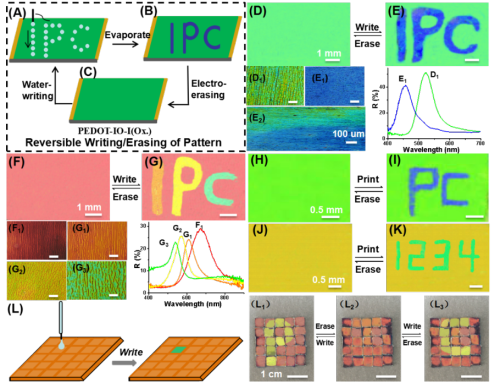Photonic crystal (PC) patterns have become an important express way for various optical applications in sensing, anticounterfeit, displays, and optical devices. The development of PC patterns experiences three processes including inactive-, responsive- and solidified- patterns. First, inactive PC patterns are manufactured from the self-assembly of latex particles based on a template or direct writing using latex inks. Second, responsive PC patterns are achieved by introducing light-, heat-, electro-, magneto-, or solvent responsive materials into a PC matrix. The pattern can reversibly respond to an external stimulus by a simultaneous change of the structure color, but the pattern disappears if the specific external stimulus is removed. Third, solidified PC patterns can be obtained by chemical reaction or cross-linking solidification, but the process is irreversible. Challenges remain in the development of novel PC pattern types that are free of extra fields and are erasable as desired. This property is important for the repeatable use of PC substrates and PC patterns.
Recently, Prof. WANG Jingxia from the Technical Institute of Physics and Chemistry, CAS and Prof. GUO Jinshan from Lanzhou University have achieved “Direct Water-Writing/Electroerasing Pattern on PEDOT Inverse Opals”.
The PEDOT-IO-0 is fabricated by potentiostatic polymerization,There are four states and three different switches of PEDOT-IOs : the first switch is the irreversible reduction of PEDOT-IO-0 to PEDOT-IO-I (neutral state). The second switch is the reversible electrochemical process between neutral and oxidized PEDOT-IO-I accompanied by a reversible stopband shift owing to ionic doping/dedoping. The third switch is the water treatment process of PEDOT-IO-I (oxidation state) to form PEDOT-IO-II, which induces a blueshift in the stopband owing to water induced removal of ions and shrinkage of the periodic structure.
Combining the switches of PEDOT-IO-I and PEDOT-IO-II, a reversible water-writing/electroerasing procedure is realized in the full-solid state. The as-prepared PC pattern could be erased electrochemically. Reversible e-paper can be successfully achieved based on the switches of PEDOT-IOs. This research provides a novel method for the fabrication of functional optic materials.

Figure. Reversible water-writing/electroerasing of PC pattern.
The study was published in Advanced Functional Materials entitled "Direct Water-Writing/Electroerasing Pattern on PEDOT Inverse Opals".
https://onlinelibrary.wiley.com/doi/10.1002/adfm.201808473
NEWS